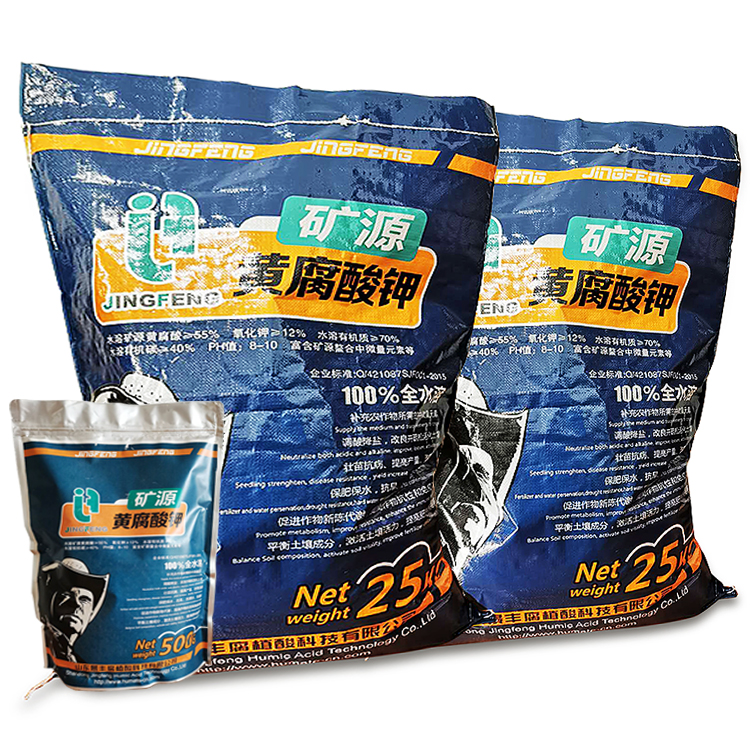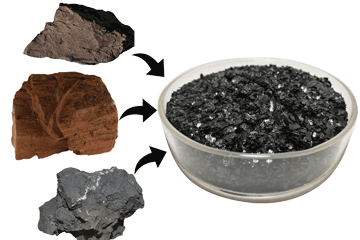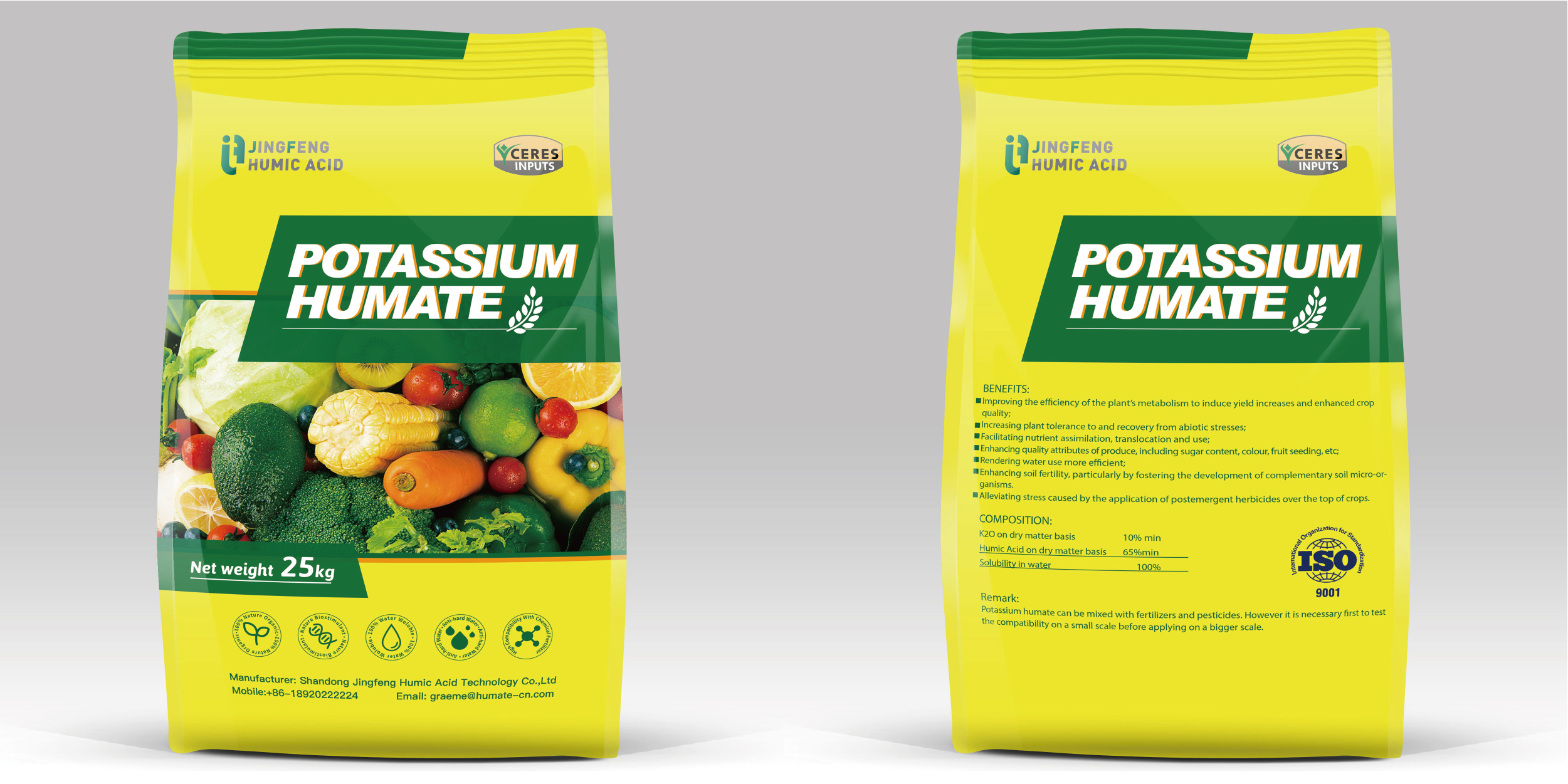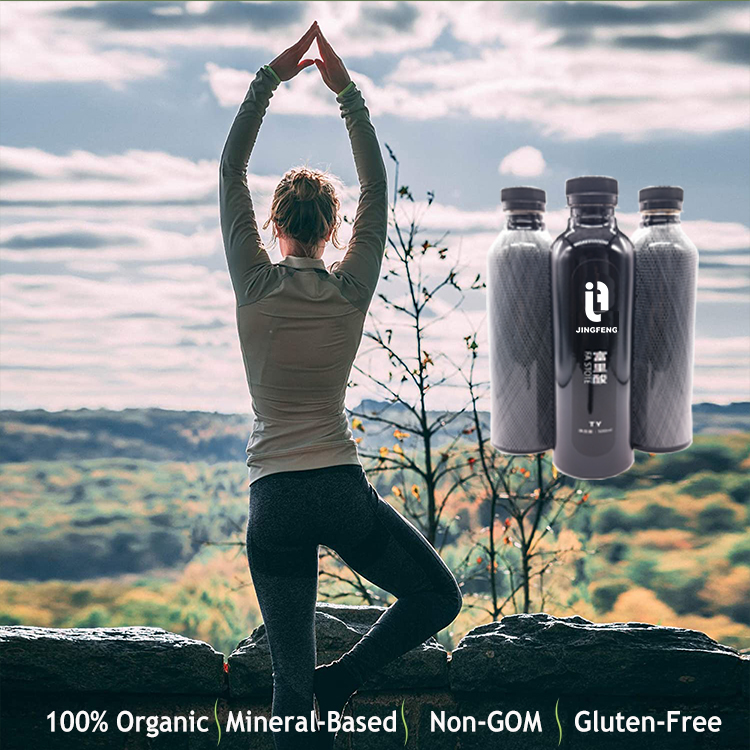
Choosing fulvic acid humic urea gives you a sustainable edge for turf care. The innovative mix of humic acids, fulvic acids, and humic substances delivers unmatched benefits for soil health and plant health. You get slow-release nitrogen that supports sustainable soil health, stronger root health, and lasting plant health. The use of fulvic acids and humic substances improves soil health by boosting soil health, increasing beneficial microbes, and maximizing nutrient benefits. This sustainable approach with humic substances, humic acids, and fulvic acids ensures your turf thrives while protecting soil health.
Here’s how fulvic acid humic urea works for sustainable turf management:
Aspect Supporting Benefits for Turf Sustainability Synthesis Method Humic acids and fulvic acids bond with urea, creating a stable, slow-release fertilizer. Nitrogen Utilization Humic substances improve nitrogen retention and delay release, raising efficiency. Soil Fertility Enhancement Humic acids and fulvic acids boost soil health, increasing total nitrogen and organic carbon. Microbial Community Impact Humic substances and fulvic acids support beneficial soil health microbes for sustainable growth. Environmental Benefits Humic acids and fulvic acids reduce nitrogen loss and lower pollution, making turf care sustainable.
Key Takeaways
- Fulvic acid humic urea improves soil health by boosting beneficial microbes and increasing nutrient retention, leading to stronger roots and healthier turf.
- This fertilizer releases nitrogen slowly, matching turf needs and reducing nutrient loss, which supports steady growth and lowers the risk of turf damage.
- Using fulvic acid humic urea helps turf resist stress from heat, cold, and drought while improving water retention, so you save water and keep grass green.
- The product reduces fertilizer runoff and pollution, making turf care more eco-friendly and protecting the environment.
- You can apply fulvic acid humic urea in liquid or dry form, making it easy to use on golf courses, sports fields, and home lawns for consistent, sustainable results.
Fulvic Acid Humic Composition
Humic Acid Role
You can see the power of humic acids when you apply them to turf. Humic acid improves soil structure and helps soil hold more water and nutrients. When you use humic substances, you boost the soil’s ability to keep nutrients available for turf roots. Research shows that humic acid increases microbial activity in soil. This leads to a 30% rise in microbial biomass carbon and a 40% increase in microbial biomass nitrogen. These changes help turfgrass use nutrients more efficiently. Humic acids also act as bio-stimulants. They encourage root growth and help turf absorb more nutrients. You get stronger roots and better nutrient uptake, which means healthier turf. Humic substances also help turf resist stress and disease. When you add humic acids to your turf program, you improve soil health and nutrient retention.
Fulvic Acid Benefits
Fulvic acids work alongside humic acids to deliver even more benefits. Fulvic acid is a smaller molecule, so it moves easily through soil and into plant roots. This helps turf absorb nutrients quickly. Fulvic acid humic blends increase nutrient uptake and improve turf color, density, and disease resistance. Studies show that fulvic acid reduces snow mold by 8% and brown spot by 12%. You also see a 6% increase in NDVI, which means better photosynthesis, and an 8% rise in chlorophyll content. These benefits make your turf greener and stronger. Fulvic acids also help turf use both macro- and micronutrients, such as nitrogen and iron, more efficiently. The combination of fulvic acids and humic acids creates a nutrient combination that supports turf health in every season.
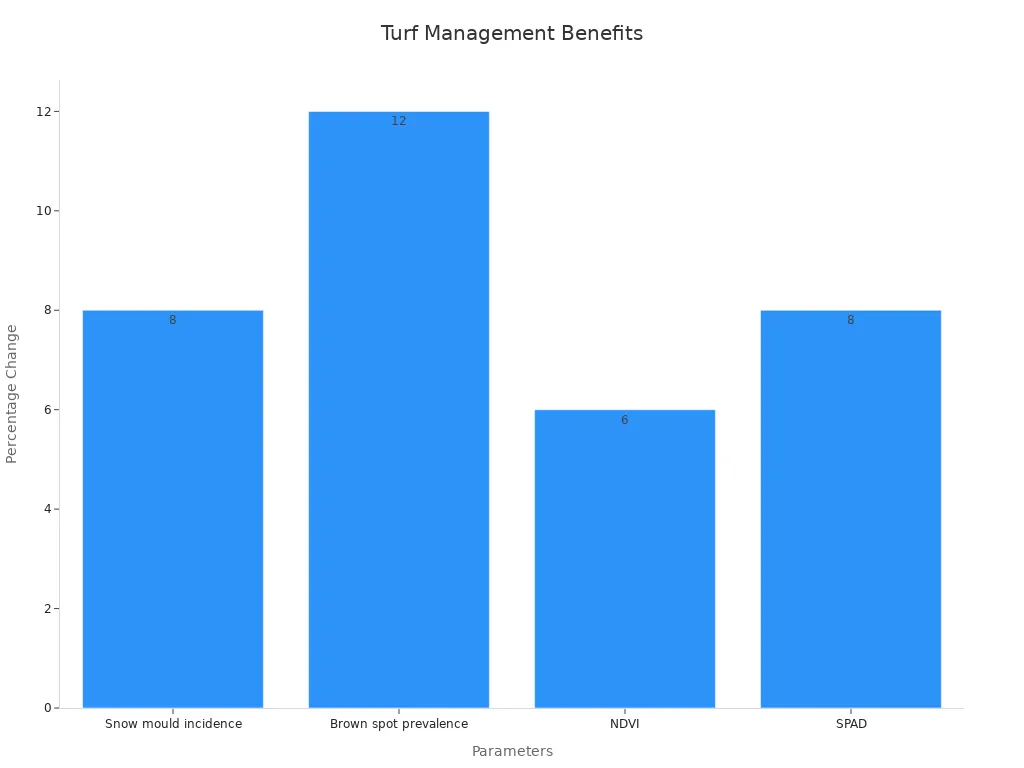
Urea Integration
Urea integration in fulvic acid humic fertilizers gives you slow-release nitrogen. This means your turf gets a steady supply of nutrients over time. Manufacturers use coatings like sulfur or polymers to control how fast urea releases nitrogen. These coatings break down slowly, so nutrients stay in the soil longer. This process matches the nutrient needs of turfgrass and reduces nutrient loss. You avoid the quick flush of growth and the risk of burning your turf. Fulvic acid humic urea also supports soil microbes, which help break down the coatings and release nutrients. This system keeps nutrients available for turf roots and improves nutrient uptake. You get consistent turf growth and fewer problems with nutrient leaching.
Discover the benefits of Humic Acid Urea for sustainable, efficient turf management today!
Tip: The unique fulvic acid humic composition in these fertilizers comes from advanced analysis methods. Fractional analysis, molecular mass distribution, and functional group analysis confirm the special biogeochemical activity of humic acids and fulvic acids. These tests show that fulvic acid humic fertilizers deliver enhanced bioactivity and superior nutrient performance for your turf.
Nutrient Efficiency
Uptake Rate
You want your turf to absorb every nutrient you apply. Fulvic acid humic urea helps you achieve this goal. The combination of humic substances and fulvic acids increases nutrient uptake by turf roots. These ingredients work together to make nutrients more available in the soil. When you use fulvic acid, you improve nutrient movement from the soil to the plant. This process supports better plant growth and stronger health for your turf.
Field studies show that optimized fertilizer blends can raise nitrogen use efficiency by 10–13% compared to incomplete treatments. Phosphorus use efficiency can increase by up to 73% when you use a complete blend. These numbers prove that fulvic acids and humic substances help your turf absorb more nutrients. You get better nutrient availability, which leads to higher crop yields and improved plant health.
| Nutrient | Efficiency Metric | Uptake Rate Increase | Notes |
|---|---|---|---|
| Nitrogen (N) | Nitrogen Use Efficiency (NUE) | 10–13% with complete NPK | Superior N absorption with optimized fertilization |
| Phosphorus (P) | Phosphorus Use Efficiency (PUE) | Up to 73% vs P-only treatments | Strong synergistic effect in NPK application |
| Potassium (K) | Potassium Uptake Efficiency | High across treatments | Influenced by soil mineralogy and environment |
| Overall | Apparent Nutrient Recovery (ANuR) | 40–65% for N, 15–25% for P, 30–50% for K | Reflects nutrient recovery efficiency |
You see these results because humic substances and fulvic acids improve nutrient uptake and nutrient availability. Your turf uses nutrients more efficiently, which supports healthy plant growth and higher crop yields. You also notice better crop health and stronger resistance to stress. This means you get more value from every application.
Slow Release
You want nutrients to last in the soil and feed your turf over time. Fulvic acid humic urea gives you this advantage. The slow-release action of this fertilizer keeps nutrient levels steady. Humic substances and fulvic acids coat the urea, so nitrogen releases slowly. This process matches the nutrient needs of your turf and reduces waste.
Field measurements confirm these benefits. You see higher soil inorganic nitrogen content and increased enzyme activity. Soil tests show more nitrate and ammonium available for plant growth. Microbial biomass carbon and nitrogen also rise, which means better soil health. These changes help your turf use nutrients for a longer period. You get improved nutrient availability and less risk of nutrient loss.
- Soil inorganic nitrogen stays high during the growing season.
- Enzyme activities like urease and nitrate reductase increase, supporting nutrient cycling.
- Microbial diversity improves, which boosts plant health and crop yields.
- Nitrogen losses from leaching or volatilization decrease, so more nutrient stays in the root zone.
- You see higher crop yields and better plant growth because nutrients remain available.
Fulvic acids and humic substances help maintain a healthy soil environment. You support strong plant growth and steady crop yields. Your turf stays green and healthy, and you use less fertilizer over time. This approach gives you reliable results and supports sustainable turf management.
Soil Health Impact

Microbial Activity
You want your turf to thrive, so you need strong soil health. Fulvic acid humic urea boosts microbial activity in your soil. When you use humic acids and fulvic acid as soil amendments, you help soil microbes grow and multiply. These humic substances increase dissolved organic matter and total organic carbon. Microbial activity rises, which means your soil health improves. You see more photosynthetic bacteria, like Rubrivivax gelatinosus, that help with carbon retention and nutrient cycling.
- Microbial activity supports better nutrient retention and soil fertility.
- Humic acids and fulvic acid encourage soil microbes to break down organic matter, releasing nutrients for your turf.
- You notice higher enzyme activity, such as urease and sucrase, which shows your soil health is getting better.
- Microbial diversity grows, making your soil more resilient and fertile.
When you apply humic substances as soil amendments, you create a healthy environment for microbes. This leads to better nutrient retention and improved soil fertility. Your turf benefits from stronger soil health and more available nutrients.
Soil Structure
Healthy soil structure is key for turf performance. Humic acids and fulvic acid work together as soil amendments to improve soil structure. These humic substances help soil particles stick together, forming stable aggregates. Good soil structure means better water retention and more air for roots. You see less compaction and more root growth.
- Humic acids increase soil organic matter, which boosts soil fertility and nutrient retention.
- Fulvic acid helps nutrients move through the soil, making them easier for roots to absorb.
- Soil amendments like fulvic acid humic urea keep soil loose and fertile, supporting strong turf health.
- Improved soil structure leads to better nutrient retention and higher soil fertility.
Over time, you notice that soil health improves with regular use of humic substances. Your turf grows deeper roots and uses nutrients more efficiently. Soil fertility stays high, and you get lasting results from your soil amendments.
Turf Performance

Stress Resistance
You want your turf to stay strong during tough weather. Fulvic acids help your turf handle stress from heat, cold, and drought. These biostimulants boost nutrient uptake and support protein synthesis. Your turf uses nutrients better, which helps with plant growth and keeps grass healthy even when conditions change. Fulvic acids also help manage reactive oxygen species, which protects turf cells from damage. You see better nutrient retention in the soil, so your turf has what it needs to recover quickly.
When you use fulvic acids, you give your turf the tools to fight stress. The benefits include stronger roots, better nutrient retention, and improved plant growth. Your turf stands up to disease and recovers faster after stress.
Here is how fulvic acids improve turf resilience:
| Performance Metric | Description / Impact |
|---|---|
| Alkali-hydrolyzed nitrogen | Higher content means more nutrient availability for plant growth. |
| Available phosphorus | Increased levels support turf health and nutrient supply. |
| Available potassium | More potassium helps with stress resistance and resilience. |
| Soil aggregate structure | Better structure improves water retention and soil health. |
| Crop yield | Higher yields show improved plant growth and vigor. |
| Weighted correlation degree (WGCD) | Top ranking for overall soil and plant performance. |
Fulvic acids work with humic acids to increase nutrient retention and water retention. You get a turf that looks green and stays healthy, even when the weather is harsh.
Water Conservation
You want to save water and keep your turf green. Fulvic acids help with water retention by improving soil structure. The soil holds more water, so you do not need to water as often. Fulvic acids increase the formation of soil aggregates, which means better water retention and less runoff. Your turf roots can reach water deep in the soil, supporting plant growth during dry periods.
The benefits of fulvic acids include better nutrient retention and water retention. Your turf uses nutrients and water more efficiently. You see less wilting and more steady plant growth. Fulvic acids also help with nutrient movement, so roots get what they need for healthy growth.
- Fulvic acids boost water retention in the soil.
- You use less water for irrigation.
- Nutrient retention stays high, so turf gets steady plant growth.
- The benefits include greener turf and lower water bills.
Tip: Use fulvic acids in your turf program to improve water retention and nutrient retention. You will see the benefits in stronger plant growth and healthier turf all season.
Environmental Advantages
Reduced Runoff
You want your turf management to support sustainable practices and protect the environment. When you use humic substances like fulvic acid humic urea, you help reduce fertilizer runoff. This is important for sustainable agriculture and for keeping water clean. Studies show that humic substances in slow-release fertilizers can lower nutrient losses from runoff by 24–56% compared to traditional fertilizers. You get more nitrogen staying in the soil, which means your turf uses nutrients better and less pollution reaches rivers and lakes.
- Humic substances coat the urea, slowing down nitrogen release.
- You see less ammonia escaping into the air and less nitrate washing away in rain.
- Sustainable turf management with humic substances keeps nutrients where your plants need them.
- You help create a sustainable system that supports healthy soil and clean water.
By choosing humic substances, you make a smart move for sustainable agriculture. You protect your turf and the environment at the same time.
Pollution Mitigation
You want to lower pollution and make your turf program more sustainable. Humic substances in fulvic acid humic urea help you do this in several ways. First, these products reduce fertilizer loss, so less nitrogen escapes into the environment. Second, humic substances help lower soil salinity, which supports sustainable agriculture and keeps your turf healthy. Third, humic substances help break down pesticide residues in the soil and water.
Scientific studies show that pesticides like flumorph and imidacloprid can break down faster when you use advanced treatment methods with humic substances. These treatments help remove harmful chemicals from water and soil, making your turf program more sustainable. You also get the benefit of humic substances working with water treatment processes to reduce pollution even further.
When you use humic substances, you support sustainable agriculture and help protect the planet. You get cleaner water, healthier soil, and a turf system that lasts for the long term.
You can see that humic substances offer more eco-friendly benefits than traditional fertilizers. They help you reach your sustainable goals and keep your turf looking its best.
Application Methods
Liquid and Dry Use
You can apply fulvic acid humic urea in both liquid and dry forms. This gives you flexibility for any turf project. If you manage a golf course, you might prefer a liquid spray for even coverage. Sports fields often need quick treatments, so a liquid application works well. For your lawn at home, you can use a dry spreader. The granules flow easily and do not create dust. You can spread them by hand or with a standard lawn spreader.
The product dissolves completely in water. You can mix it in a tank and spray it over your lawn. This method helps nutrients reach the roots fast. If you choose the dry method, you can spread the granules before watering. Water helps the nutrients move into the soil. Both methods work for large areas or small lawns. You can use this fertilizer on commercial lawns, sports turf, golf greens, and your own backyard lawn.
Tip: Choose the method that fits your equipment and the size of your lawn. Both liquid and dry applications give you strong results.
Best Practices
You want the best results for your lawn. Start by reading the label for the right rate. For a liquid application, mix the product with water as directed. Use a sprayer for even coverage. For dry use, spread the granules evenly across your lawn. Water your lawn after spreading to help the nutrients soak in.
Apply fulvic acid humic urea during the growing season. Early morning or late afternoon works best. Avoid windy days to keep the product on your lawn. Clean your equipment after use. Store any leftover product in a dry place.
You can use this fertilizer on many types of turf. It works for golf courses, sports fields, commercial properties, and your home lawn. The easy handling and water solubility make it simple to use. You get healthy turf and a green lawn with less effort.
Fulvic Acid Humic vs. Conventional Fertilizers
Performance
When you compare fulvic acid humic urea to conventional fertilizers, you see clear differences in how they support your turf and crops. Fulvic acid humic urea improves soil fertility and helps your plants use nutrients more efficiently. You get better crop growth and higher yield. Humic substances in this fertilizer increase the size and strength of soil aggregates, which means your soil holds water and nutrients better. This leads to stronger roots and healthier plants.
Here is a table that shows how fulvic acid humic urea outperforms conventional urea fertilizer:
| Metric | Fulvic Acid Humic Urea | Conventional Urea Fertilizer | Improvement |
|---|---|---|---|
| Soil aggregate content (>0.25 mm) | Increased by 9.6% | Baseline | +9.6% |
| Mean weight diameter of aggregates | Increased by 19.8% | Baseline | +19.8% |
| Geometric mean diameter of aggregates | Increased by 21.7% | Baseline | +21.7% |
| Humic acid content | Increased by 5.5% | Baseline | +5.5% |
| Fulvic acid content | Increased by 5.5% | Baseline | +5.5% |
| Lignin-like molecules | Increased by 0.94 times | Baseline | +94% |
| Protein-like molecules | Increased by 3.69 times | Baseline | +269% |
| Soil NH4+-N and NO3−-N content | Increased by 23.3–24.5% | Baseline | +23.3–24.5% |
| Sap bleeding rate | Increased by 12.8–18.2% | Baseline | +12.8–18.2% |
| Nitrogen delivery rate through sap | Increased by 60.6–87.7% | Baseline | +60.6–87.7% |
| Crop yield (max) | 9890 kg ha−1 at 286 kg N ha−1 | 8294 kg ha−1 at 312 kg N ha−1 | +19.1% yield with less N |
| Average yield improvement (3 seasons) | 9.4–14.0% higher | Baseline | +9.4–14.0% |
You can see that humic substances boost soil fertility and help your crop reach its full potential. Your plants get more nutrients, and you see a clear increase in yield. Humic substances also improve the soil structure, which supports long-term fertility and healthy crop growth.
Cost Savings
You want to get the most value from your fertilizer investment. Fulvic acid humic urea helps you save money by increasing crop yield and reducing the amount of fertilizer you need. When you use humic substances, your crops use nitrogen more efficiently, so you can apply less fertilizer and still get better results. Over several seasons, studies show that adding humic substances to urea increases pasture dry matter production by up to 70% in the first season and by 12-20% in later seasons compared to urea alone.
- Fertilizer application with humic substances increased crop yield by up to 41% in spring.
- Adding just 0.5% humic acids to urea fertilizers raised crop yields by 5.58% to 18.67%.
- Nitrogen use efficiency improved by 3.70 to 12.00 percentage points.
- These improvements mean you spend less on fertilizer and get more crop for your money.
You also benefit from lower fertilizer costs and higher net profit per hectare. The chart below shows how fulvic acid humic urea compares to other fertilizers in terms of cost:

When you choose humic substances, you support soil fertility, boost crop yield, and keep your costs down. This makes fulvic acid humic urea a smart choice for anyone who wants healthy crops and sustainable fertility.
You want a turf solution that works for both your lawn and the environment. Fulvic acid humic urea gives you that edge. You see stronger roots, greener grass, and less need for extra fertilizer. Studies show a 12% average yield increase and better water retention. You also help the planet by reducing runoff and soil erosion.
- Lower fertilizer use and input costs
- Healthier soil with more organic matter
- Stronger plants that resist stress
Consider talking with a turf specialist or exploring product options to see these benefits for yourself.
FAQ
What makes fulvic acid humic urea better for turf than regular urea?
You get slow-release nitrogen and improved nutrient uptake. Fulvic acid and humic acid help your turf absorb more nutrients. Your soil stays healthy, and your grass grows stronger and greener.
Can I use fulvic acid humic urea on any type of turf?
Yes, you can use it on golf courses, sports fields, home lawns, and commercial landscapes. The product works well for all turf types and helps you achieve healthy, green grass.
How do I apply fulvic acid humic urea?
You can spread the granules dry or dissolve them in water for spraying. Always follow the label instructions. Water your turf after applying dry granules to help nutrients reach the roots.
Is fulvic acid humic urea safe for the environment?
Yes, it is eco-friendly. You help reduce fertilizer runoff and pollution. The product also helps break down pesticide residues and lowers soil salinity, supporting a healthier environment.
How often should I apply fulvic acid humic urea?
Apply during the growing season for best results. Most turf managers use it every 4 to 6 weeks. Check your turf’s needs and adjust the schedule as needed.



